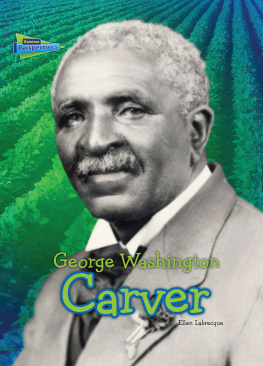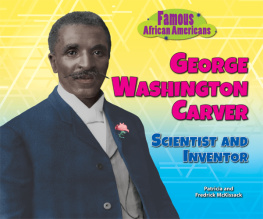
Copyright 2019 by Peggy Thomas
All rights reserved
Published by Chicago Review Press Incorporated
814 North Franklin Street
Chicago, Illinois 60610
ISBN 978-0-915864-00-3
Library of Congress Cataloging-in-Publication Data
Names: Thomas, Peggy, 1960 author.
Title: George Washington Carver for kids : his life and discoveries with 21 activities / Peggy Thomas.
Description: Chicago, Illinois : Chicago Review Press Incorporated, [2019] | Audience: Age 9. | Audience: Grades 4 to 6. | Includes bibliographical references and index.
Identifiers: LCCN 2018035154 (print) | LCCN 2018035951 (ebook) | ISBN 9780915864041 (Pdf) | ISBN 9780915864058 (Epub) | ISBN 9780915864102 (Kindle) | ISBN 9780915864003 (trade paper)
Subjects: LCSH: Carver, George Washington, 1864?1943Juvenile literature. | Tuskegee InstituteHistoryJuvenile literature. | African American agriculturistsBiographyJuvenile literature. | AgriculturistsUnited StatesBiographyJuvenile literature. | African American scientistsBiographyJuvenile literature. | ScientistsBiographyJuvenile literature.
Classification: LCC S417.C3 (ebook) | LCC S417.C3 T485 2019 (print) | DDC 630.92 [B] dc23
LC record available at https://lccn.loc.gov/2018035154
Cover design: Jonathan Hahn
Cover images: (front, clockwise from top right) Carver in his lab, Tuskegee University Archives, Tuskegee University; Tuskegee University seal, photo by author; preserved fruits and vegetables, photo by author; Carver teaching a botany class, Tuskegee University Archives, Tuskegee University; peanuts, Krzysztof Puszczyski/Pexels; (back, clockwise from top right) Carver tends to plants, Tuskegee University Archives, Tuskegee University; Carver the artist, courtesy of the George Washington Carver National Monument; gourd activity, illustration by Lindsey Cleworth Schauer
Interior design: Sarah Olson
Interior illustrations: Lindsey Cleworth Schauer
Printed in the United States of America
5 4 3 2 1

CONTENTS

TIME LINE

186465 | George Washington Carver born in Diamond Grove, Missouri |
1876 | Attends school in Neosho, Missouri |
1879 | Travels to Fort Scott, Kansas |
1880 | Moves to Minneapolis, Kansas |
1885 | Rejected from Highland College (Kansas) |
1886 | Homesteads in Beeler, Kansas |
1888 | Moves to Winterset, Iowa |
1890 | Enrolls at Simpson College, Indianola, Iowa |
1891 | Student at Iowa Agricultural College, Ames, Iowa |
1893 | Painting wins honorable mention at the Worlds Columbian Exposition in Chicago |
1894 | Graduates from Iowa and becomes first black faculty member |
1896 | Becomes director of agricultural department at Tuskegee Institute, Alabama |
1906 | Creates the Jesup Wagon |
1916 | Member of the British Royal Society of Arts |
1921 | Speaks to US Congress about the peanut |
1933 | Works with polio patients |
1935 | Collaborates with USDA on mycology research Austin Curtis arrives in Tuskegee |
1937 | Speaks at chemurgy conference in Dearborn, Michigan |
1941 | Opens the George Washington Carver Museum |
1943 | Dies January 5 in Tuskegee, Alabama |




George Washington Carver.
Tuskegee University Archives, Tuskegee University
ALL THAT IS KNOWN


No individual has any right to come into the world and go out of it without leaving behind him distinct and legitimate reasons for having passed through it. George Washington Carver

T oday, most Americans recycle paper, plastic, and metal cans. We use biodegradable shopping bags and may even compost our kitchen scraps. Our cars are built with soybean plastic parts, and fueled by corn-based ethanol. George Washington Carver would be pleased. He spent most of his life promoting conservation and developing new products from agriculture.

Thenceforward, and forever free. Emancipation Proclamation.
Courtesy of the Library of Congress, LC-DIG-pga-02040
These ideas seem commonplace today, but they were unusual 100 years ago. There were plenty of natural resources, and farmers just focused on growing food and fiber crops without worrying about whether they were using those resources efficiently. But Carver saw a lot was going to waste, and he met too many poor farmers who could barely feed themselves as a result. He had to do something. Carvers work in conservation and agriculture was all part of a bigger vision. He saw a world where people lived in harmony with nature and with each other. This vision began long before he became famous for developing dozens of peanut products. It was rooted in a lifetime of struggle and uncertainty. George struggled against poverty and racism, and was uncertain about who he was, what he could be, and where he came from.
Next page
























